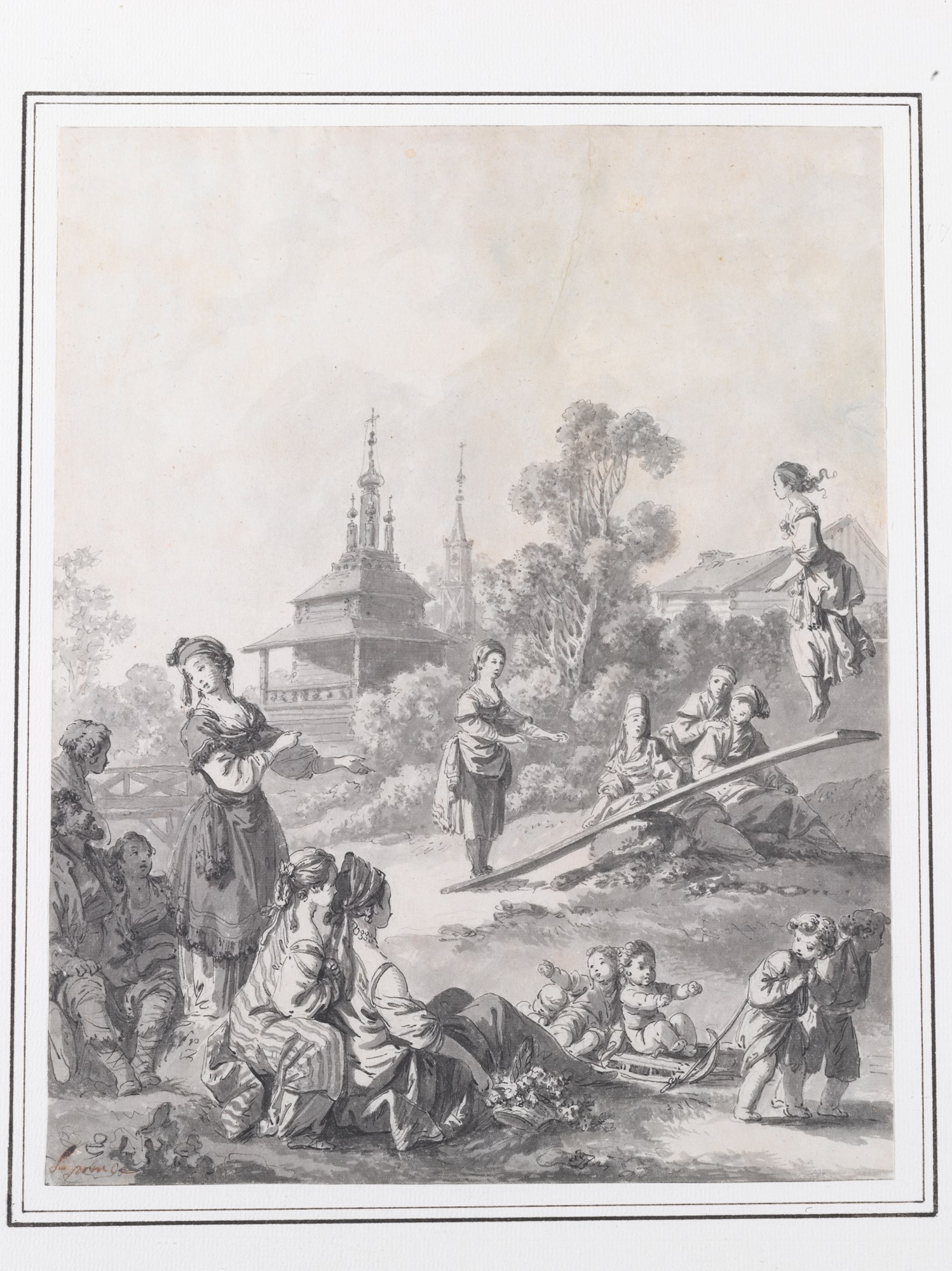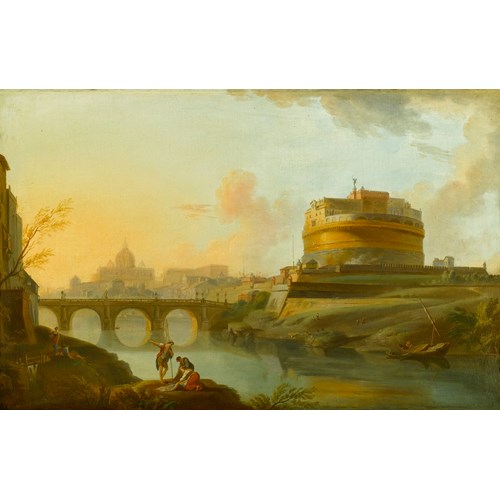Marketplace
The Russian Dance
&
The Seesaw
Jean-Baptiste Le Prince
The Russian Dance & The Seesaw
Medium black chalk, pen and black ink, grey wash, en grisaille
The present pair of drawings encapsulates the exoticism and sense of playfulness for which the work of Jean-Baptiste Le Prince is best known. The Russian Dance is one of Le Prince’s best known images, due to its wide dissemination through print. A turbaned man and an elegant young woman are dancing together in a small clearing. They are accompanied by two musicians and watched by a small crowd huddled under the shade of a tent. In the foreground a Kalmyk archer, his quiver by his side, has turned away from the entertainment and placed his arm around the lady sitting beside him. The aquatint version of the present drawing was one of the works which Le Prince exhibited at the Paris Salon in 1769.
The Seesaw, seems to be set on the outskirts of a Russian village, with a wooden church dominating the background. A long plank of wood has been balanced on a rock to create a makeshift seesaw, which has sent a young girl soaring into the air. In front of them two small children struggle to pull a further three along on a sled. Surrounding them various figures enjoy the sunshine, whilst watching the youngsters at play.
The theme of Russian peasants at leisure, and more specifically music and dance were common themes in Le Prince’s work. A Russian Fête Champêtre has only small variations from The Russian Dance, featuring many of the same figures and motifs. Similarly, the engraving also called La Danse Russe, which was used as an illustration in Jean-Baptiste Chappe d’Auteroche’s (1722-1769) famous travelogue Voyage en Sibérie, is comparable to both of the present works (fig. 1). Again the central subject is that of a couple engaged in a dance whilst a crowd looks on. In all the works Le Prince’s ethnographic interest is in evidence, as he tries to convey the exoticism of Russia to his French audience. He focuses on details such as the costume of his figures or the musical instruments which they play. This interest in the differences between Russian and French culture made his scenes the perfect accompaniments to Chappe’s text. Although there is no comparable aquatint to The Seesaw, it does seem to relate to Chappe’s description of ‘Young women sometimes amuse themselves on nice days by jumping on a plank balanced on a log lying on the ground: they stand on the end of the plank and raise themselves by turns, five or six feet high, with the greatest skill’.¹ In 1786 Le Prince also executed a pair of paintings whose subjects correspond to those of the present drawings.²
Le Prince began in studies in Metz, but in 1750 was sponsored to go to Paris and become a pupil of François Boucher (1703-1770). In 1758 he moved to St. Petersburg, where he worked for Catherine the Great and spent five years travelling amongst the Russian people. The drawings he produced during this period served as the basis for the majority of his work upon his return to France, and his work was extremely popular due to their exotic nature. His russeries were part of the Rococo trend that saw foreign subjects and motifs, especially Chinese and Turkish, achieve great popularity. He exhibited regularly at the Salon, provided cartoons for tapestries and produced several collections of etchings and aquatints on Russian themes. In fact due to his pioneering role in the use of aquatint he left an enduring legacy to the art of printmaking.
¹ Quoted in Drawings by Jean-Baptiste Le Prince for the Voyage en Sibérie, exhib. cat., (Rosenbach Museum and Library, Philadelphia, and other locations, 1986), p. 15.
² Ibid, nos. 37 & 38.
29 x 23.7 cm (11⅜ x 9¼ in); 29 x 22.8 cm (11⅜ x 9in)
The Seesaw, seems to be set on the outskirts of a Russian village, with a wooden church dominating the background. A long plank of wood has been balanced on a rock to create a makeshift seesaw, which has sent a young girl soaring into the air. In front of them two small children struggle to pull a further three along on a sled. Surrounding them various figures enjoy the sunshine, whilst watching the youngsters at play.
The theme of Russian peasants at leisure, and more specifically music and dance were common themes in Le Prince’s work. A Russian Fête Champêtre has only small variations from The Russian Dance, featuring many of the same figures and motifs. Similarly, the engraving also called La Danse Russe, which was used as an illustration in Jean-Baptiste Chappe d’Auteroche’s (1722-1769) famous travelogue Voyage en Sibérie, is comparable to both of the present works (fig. 1). Again the central subject is that of a couple engaged in a dance whilst a crowd looks on. In all the works Le Prince’s ethnographic interest is in evidence, as he tries to convey the exoticism of Russia to his French audience. He focuses on details such as the costume of his figures or the musical instruments which they play. This interest in the differences between Russian and French culture made his scenes the perfect accompaniments to Chappe’s text. Although there is no comparable aquatint to The Seesaw, it does seem to relate to Chappe’s description of ‘Young women sometimes amuse themselves on nice days by jumping on a plank balanced on a log lying on the ground: they stand on the end of the plank and raise themselves by turns, five or six feet high, with the greatest skill’.¹ In 1786 Le Prince also executed a pair of paintings whose subjects correspond to those of the present drawings.²
Le Prince began in studies in Metz, but in 1750 was sponsored to go to Paris and become a pupil of François Boucher (1703-1770). In 1758 he moved to St. Petersburg, where he worked for Catherine the Great and spent five years travelling amongst the Russian people. The drawings he produced during this period served as the basis for the majority of his work upon his return to France, and his work was extremely popular due to their exotic nature. His russeries were part of the Rococo trend that saw foreign subjects and motifs, especially Chinese and Turkish, achieve great popularity. He exhibited regularly at the Salon, provided cartoons for tapestries and produced several collections of etchings and aquatints on Russian themes. In fact due to his pioneering role in the use of aquatint he left an enduring legacy to the art of printmaking.
¹ Quoted in Drawings by Jean-Baptiste Le Prince for the Voyage en Sibérie, exhib. cat., (Rosenbach Museum and Library, Philadelphia, and other locations, 1986), p. 15.
² Ibid, nos. 37 & 38.
29 x 23.7 cm (11⅜ x 9¼ in); 29 x 22.8 cm (11⅜ x 9in)
Medium: black chalk, pen and black ink, grey wash, en grisaille
Signature: The first signed and dated ‘Le Prince 1769’ (lower right) and the second bears a signature ‘le prince’ (lower left).
Plus d'œuvres d'art de la Galerie








, in a Green Dress and Pearls, Standing at a Draped _T638990626119457264.jpg?width=500&height=500&mode=pad&scale=both&qlt=90&format=jpg)
